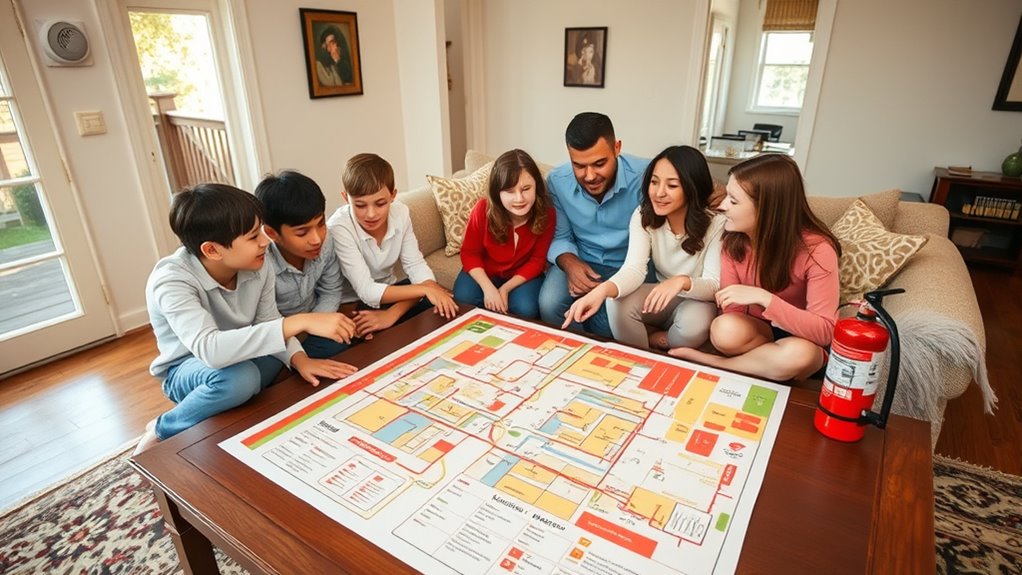To create an effective fire emergency plan at home, identify two accessible exits from each room, like doors and windows, and practice escape routes regularly with everyone. Assign a safe outdoor meeting spot and keep emergency essentials nearby. Make sure all household members understand the plan and check fire alarms and smoke detectors monthly. Keep fire extinguishers handy and educate your family about fire hazards. Continuing this process helps guarantee your family stays prepared and safe during a fire emergency.
Key Takeaways
- Identify two accessible exits from each room and ensure they are unobstructed.
- Practice fire escape routes regularly with all household members.
- Designate a safe outdoor meeting spot for quick headcounts after evacuation.
- Keep emergency essentials like flashlights, phones, and fire escape kits nearby.
- Educate everyone on fire hazards, fire safety procedures, and how to execute the escape plan.

Fire safety at home is vital to protect yourself and your loved ones from the dangers of fires. One of the most effective ways to do this is by creating a solid emergency plan that everyone understands and practices regularly. The first step in this process involves making sure your home is equipped with reliable fire alarm installation. These alarms are your first line of defense, alerting you to dangers before smoke becomes overwhelming. When installing fire alarms, place them on every level of your home, especially in the kitchen, bedrooms, and hallways. Test each alarm monthly and replace batteries at least once a year, or as recommended by the manufacturer. Smoke detector maintenance is equally important; clean your smoke detectors regularly to prevent dust and debris from causing false alarms or preventing them from sounding when needed. Properly maintained smoke detectors can save lives by providing early warning, giving you precious seconds to escape.
Once your fire alarms are installed and functioning correctly, you should develop a clear escape plan. Start by identifying two exits from each room — doors and windows — and make sure they’re accessible at all times. Practice your escape route regularly with everyone in your household, so each person knows exactly what to do when the alarm sounds. Designate a safe meeting spot outside your home, such as a neighbor’s yard or a mailbox, so you can quickly account for everyone. Make sure all members, including children and seniors, understand the plan and feel confident in executing it. Keep emergency essentials like flashlights, a phone, and a basic fire escape kit nearby, and make certain everyone knows how to use them.
In addition to practicing escape routes, it’s vital to review your fire safety measures periodically. Check your fire alarms and smoke detectors at least once a month, replacing batteries or units as needed. Consider upgrading older alarms to newer models with longer-lasting batteries or interconnected systems that sound simultaneously when one detects smoke. Educate your family about fire hazards — such as unattended cooking or faulty wiring — and encourage safe habits. Keep fire extinguishers accessible in key areas and make sure everyone knows how to use them properly. By combining diligent fire alarm installation, ongoing smoke detector maintenance, and a well-practiced emergency plan, you can markedly reduce the risk of injury or damage during a fire. Preparing now creates peace of mind, knowing you’re ready to respond swiftly and safely should disaster strike.
Frequently Asked Questions
How Often Should I Update My Home Fire Emergency Plan?
You should review and update your home fire emergency plan at least once a year. Regular fire drill frequency helps make certain everyone knows what to do in an emergency. Additionally, consider reviewing your plan whenever there are significant changes in your household, such as new family members or moving to a new home. Keeping your emergency plan current ensures you’re prepared for any fire situation, reducing confusion and increasing safety.
What Are the Best Fire Safety Apps for Home Use?
Like a trusty flashlight in a dark room, fire safety apps brighten your home safety tech. Apps like Red Cross Emergency, First Aid, and Home Fire Safety provide quick tips, alerts, and evacuation guidance. They’re easy to use and keep you informed, making them essential tools for your home safety technology. Download a few to stay prepared and confident, turning your smartphone into a reliable partner in fire safety.
How Can I Help Children Understand Fire Safety?
To help children understand fire safety, focus on engaging them through fire safety education that’s fun and interactive. Use simple language and relatable scenarios to explain dangers and safety tips. Encourage child engagement by involving them in fire drills and safety discussions. Reinforcing these lessons regularly builds their confidence and awareness, making them more prepared in emergencies. Your active participation makes fire safety an important and memorable part of their daily lives.
What Should I Include in a Fire Safety Kit?
You’d think a fire safety kit is just a fancy box, but it’s your lifeline. Include a fire extinguisher to fight flames, smoke alarms to alert you early, and emergency essentials like water, snacks, and a flashlight. Don’t forget a first aid kit and important documents. Ironically, preparedness can turn chaos into control—so pack wisely, because staying safe means being ready for the unexpected.
Are Fire Sprinklers Effective in Residential Homes?
Fire sprinkler effectiveness in residential homes is quite high, providing quick response to fires. Residential fire sprinklers activate early, often controlling or extinguishing fires before they spread, giving you essential extra time to escape. While not a substitute for smoke alarms and fire safety plans, residential fire sprinklers greatly enhance safety. Installing these systems can help protect your family and property, making them a smart addition to your fire prevention strategy.
Conclusion
By creating a clear emergency plan, you’re taking vital steps to protect yourself and your loved ones. Some might think it’s unnecessary or time-consuming, but being prepared can make all the difference in a fire. Imagine yourself calmly escaping to safety, knowing exactly what to do. Don’t wait for disaster to strike—plan today and make certain everyone knows how to stay safe. Your preparedness could save lives when it matters most.









